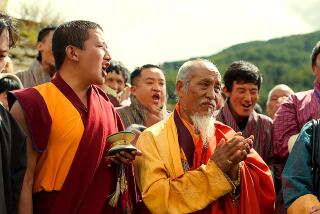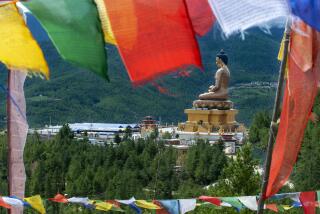King Fears Immigrants Threaten Bhutan : Asia: Sporadic violence has continued since an uprising last year by members of ethnic group that makes up 28% of the population.
- Share via
THIMPHU, Bhutan — Bhutan, hidden deep in the mountains between India and China, no longer qualifies for its travel book description of “the last Shangri-La.”
King Jigme Singye Wangchuk says that his small Himalayan kingdom faces the greatest threat to its survival since the 7th Century.
Peace was shattered in September by an uprising of militants from the kingdom’s ethnic Nepali minority. Sporadic violence has continued since.
The 35-year-old king said in a recent interview that he believes the problem will continue for at least another year, but can be solved through “honest, sincere and genuine dialogue.”
He makes frequent visits to the troubled southern districts, where most of the immigrants live, in an effort to redress grievances. He has ordered the release of hundreds of Nepali “anti-nationals” arrested in the last four months.
Wangchuk said his greatest concern is the influx of migrants.
“Right now, the factor that is at stake for us is basically the survival of the Bhutanese people,” he said.
“After all these years, since the 7th Century, we have never ever been dominated by any foreign power. We have always somehow miraculously been able to defend our sovereignty and our security,” he said.
“The threat is that if we are not careful, and if this large influx of Nepalis keeps coming into Bhutan, and if the Nepalis in Bhutan want to create their own separate state and have their own separate identity, then we feel that it is only a matter of time--in the next 10, 15 or 20 years--before Bhutan will no longer be a Bhutanese nation.
“It will be a Nepali state . . . just like Sikkim . . . unless this problem is amicably and effectively solved.”
Neighboring Sikkim, once an independent monarchy, was annexed by India in 1975. Its last royal ruler was Wangchuk’s uncle.
Like the Bhutanese, the ethnic Sikkimese are mainly of Mongol stock. They are related to Tibetans, who share their Buddhist religion.
Nepali migrants, many of them ethnically Indo-Aryans and mainly Hindu, made the Sikkimese a minority in their own land.
Bhutan, with an area the size of Switzerland, has a population officially put at 600,000. Wangchuk said a recent census had shown that 28% were of Nepali origin.
The census also uncovered large numbers of illegal Nepali immigrants, many of whom were expelled but joined the uprising and accused the government of racism, apartheid and despotism.
Today, an estimated 5 million Nepalis live in cramped settlements on the Indian side of Bhutan’s border.
Southern Bhutan was ideal for Nepali migration, the king said, because of its free education and health services, higher wages and good land available for cash crops.
Along the long, thickly forested border with the Indian states of Assam and West Bengal, it had been impossible for Bhutan’s weak administrative system to check the influx, he said.
The king said the revolt was led by a group called the Bhutan People’s Party, whose militants number about 1,000.
They are helped by Nepalis in India to whom they promised Bhutanese citizenship and free land, and by groups in India and Nepal who want a pan-Himalayan Nepali state.
Dialogue has been difficult with the Bhutan People’s Party because they have no clear leader, the king said.
“The BPP has become extremely unpopular in southern Bhutan because they have raided a lot of villages and killed a lot of innocent people,” the king said.
“When they could not extort money, they started stealing and robbing people. When that didn’t work, they started kidnaping for ransom. The whole organization has now become not only a terrorist organization, but they are actively involved in murdering people.”
At least 30 people have been killed so far in cross-border raids, decapitations, kidnapings, vehicle hijackings, ambushes, dynamite bombings and clashes with security forces.
Schools are closed; many have been destroyed. Post offices, police, health, forest, customs and agricultural offices have been wrecked. Thimpu officials do not dare to venture out in national dress in the troubled south.
The first stirrings of protest were a backlash against government edicts dating from 1988, implemented by overzealous officials and aimed at preserving Bhutan’s cultural identity as part of its “one-nation, one-people” policy of integration.
One edict required Bhutanese to wear national dress on public occasions. Another prescribed a code of conduct based on Buddhist precepts, and another ordered the teaching of Dzongkha, the national language, in schools. Teaching in the Nepali language was stopped in 1989.
The king said measures to deter the Nepali influx would include regular censuses, improved checking systems and strengthening the administration in the southern foothills.
More to Read
Sign up for Essential California
The most important California stories and recommendations in your inbox every morning.
You may occasionally receive promotional content from the Los Angeles Times.













